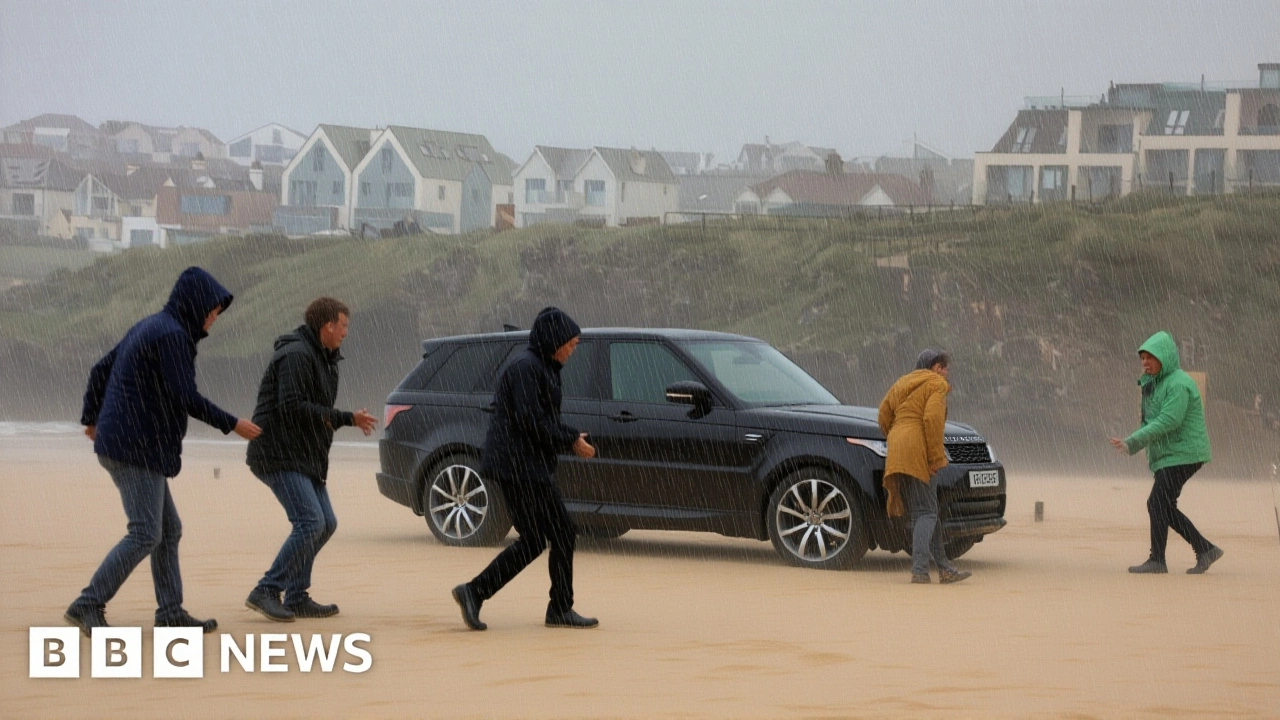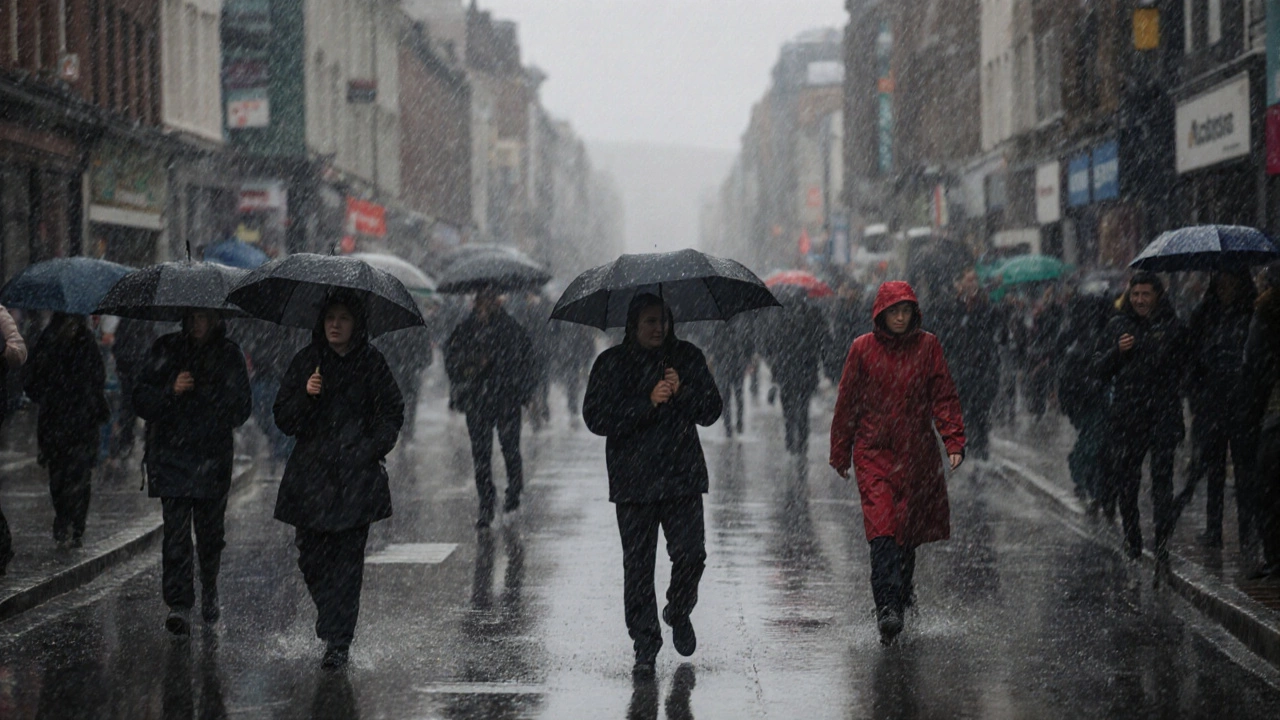When Storm AmyUnited Kingdom slammed into the British Isles on 3 October, the Met Office issued unprecedented wind warnings. The Scottish island of Tiree logged a gust of 96 mph, the strongest measured this season, while Capel Curig in North Wales saw 85 mph and 43 mm of rain in a single hour. By Saturday morning, at least one person had died and hundreds of thousands were left without electricity across England, Scotland, Wales and Northern Ireland.
How Storm Amy Formed
The low‑pressure centre that became Storm Amy originated deep in the Atlantic on 1 October. An unusually vigorous jet stream, tracking farther north than usual, acted like a conveyor belt, pulling the system rapidly eastward. What set this storm apart was the leftover moisture and vorticity from the remnants of Hurricanes Humberto and Imelda. Those tropical leftovers bumped into the jet stream, intensifying its wind shear and causing the Atlantic low to deepen dramatically on Friday.
By the time the system reached the western coast of Scotland, pressure had fallen to 970 hPa, a value more typical of a Category 2 hurricane. The rapid deepening, known as explosive cyclogenesis, explains why gusts topped 90 mph in exposed coastal areas of the Highlands and why the storm retained its fury well into Saturday night.
What the Met Office Warned
At 06:00 GMT on 3 October, the Met Office released a yellow national weather warning, covering the whole of Britain. An amber warning followed for western parts of Northern Ireland, western Scotland and the far‑north coastal zones, signalling danger to life. In its bulletin, the Met Office warned that "exposed areas could experience gusts of up to 90 mph again" and that "heavy rain will accompany the winds, making high‑sided vehicles especially vulnerable on exposed routes".
Senior meteorologist Dr. Helen Skidmore told reporters, "The combination of an active jet stream and tropical remnants is rare for October, so we urged people to stay indoors, secure loose objects and keep chargers handy in case of power cuts."
Impact on Communities and Infrastructure
Power companies scrambled to restore supply, but the sheer number of downed lines meant that at the peak, more than 320,000 households were without electricity. In the Shetland Islands, the outage lasted 18 hours, while parts of the Scottish mainland saw lights return after 10 hours. The storm also triggered landslides on the western slopes of the Lake District, temporarily closing two minor roads.
- Wind gusts: 96 mph (Tiree), 85 mph (Capel Curig), 70‑80 mph across much of Scotland.
- Rainfall: Up to 43 mm in one hour at Capel Curig.
- Fatalities: 1 confirmed death, a 68‑year‑old man crushed by a falling tree in County Antrim.
- Transport: ScotRail cancelled five services on the West Highland Line; speed restrictions of 40 mph imposed on all other routes.
ScotRail issued a statement: "Passenger safety is our priority. We have suspended services on vulnerable sections and are working with Network Rail to clear debris as quickly as possible." The statement also noted that ferry services between the mainland and the Outer Hebrides were delayed due to high seas.
Responses from Authorities and Experts
Local councils across Wales activated their emergency planning teams, setting up rest centres for those whose homes were damaged. In England, the Department for Business, Energy & Industrial Strategy (BEIS) pledged an extra £5 million for rapid repair of critical infrastructure.
Climate scientists see Storm Amy as a bellwether. Professor James Thornton of the University of Exeter warned, "We are likely to see more October storms of this intensity as the Atlantic warms. The jet stream is becoming more erratic, and the merger of tropical remnants with mid‑latitude systems is a pattern we need to monitor closely."
Residents, meanwhile, voiced a mixture of frustration and admiration. A farmer from the Isle of Mull, who asked to remain unnamed, said, "The wind ripped the roof off the barn, but the Met Office gave us enough notice to batten down the hatches. Without that warning, it could have been far worse."
Looking Ahead: What This Means for the 2025‑26 Season
Storm Amy marks the first named storm of the 2025‑26 season, and early forecasts suggest that the jet stream will remain active through winter. The Met Office has already placed a "high" confidence flag on the likelihood of at least three more named storms before the end of December.
Utility companies are reviewing contingency plans, and the government is expected to commission a review of coastal defenses after several sea walls reported damage along the Moray Firth. Meanwhile, the public is being urged to keep emergency kits ready, especially in the Highlands and coastal communities where power restoration can take days.

Frequently Asked Questions
How did Storm Amy develop so quickly?
The storm intensified when the Atlantic low merged with the remnants of Hurricanes Humberto and Imelda. Those tropical leftovers injected extra moisture and spin into the system, while a powerful jet stream acted like a fast‑moving conveyor, pulling the low eastward and deepening its pressure dramatically on Friday.
Which areas suffered the worst wind damage?
The Scottish island of Tiree recorded the highest gust at 96 mph, followed closely by Capel Curig in North Wales with 85 mph. Exposed coastal and high‑land regions of Scotland, as well as the north‑west of England, also saw sustained gusts of 70‑80 mph, leading to widespread power outages and structural damage.
What precautions did the Met Office advise?
The Met Office issued yellow and amber warnings, urging people to secure loose objects, avoid high‑sided vehicles on exposed routes, keep emergency supplies handy, and stay indoors during peak gust periods. They also warned of possible flooding from heavy rain in western Scotland and Wales.
How many people lost power and how long did outages last?
More than 320,000 households experienced power cuts. In the hardest‑hit areas, such as the Shetland Islands, power was restored after roughly 18 hours; most of mainland Scotland saw electricity back within 10 hours, though some remote communities took longer.
Will similar storms be expected this winter?
Meteorologists say the jet stream will remain unsettled through the winter months, increasing the chance of further named storms. The Met Office has placed a high confidence level on at least three more significant storms before the end of December, meaning residents should stay prepared.



